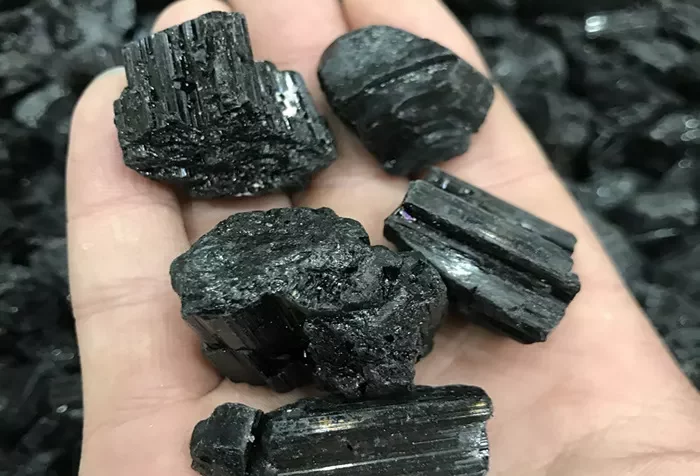In the vast world of gemstones and crystals, two particularly intriguing and powerful stones stand out: black obsidian and black tourmaline. Both have unique properties, meanings, and uses that have captivated individuals for centuries. This article aims to provide a detailed introduction to these two stones, explaining their differences from a professional jewelry appraiser’s perspective.
What is Black Obsidian?
Formation and Characteristics
Black obsidian is a type of natural volcanic glass formed when molten lava rapidly cools. This rapid cooling process prevents the lava from crystallizing, resulting in a smooth, glassy surface. Unlike crystals, obsidian has no crystalline structure. Instead, it is composed of a fine-grained mixture of minerals, primarily silicon dioxide (SiO2).
Black obsidian is characterized by its deep, shiny black color, often with a slight greenish or brownish hue. It has a vitreous luster and can be translucent to opaque. The stone is known for its hardness, ranging from 5 to 5.5 on the Mohs scale, making it relatively durable for jewelry use.
Spiritual and Healing Properties
In spiritual and metaphysical circles, black obsidian is revered for its ability to confront the shadow self and enter the realm of darkness. It is often associated with protection, grounding, and purification. The stone’s dark color and dense energy make it an ideal choice for those seeking to confront and overcome their deepest fears and insecurities.
Black obsidian is believed to have a strong gravitational pull that draws out negative energies and emotions. It is often used in meditation and spiritual work to help individuals face their shadows and achieve a deeper level of self-awareness. The stone’s ability to ground and stabilize energy is also highly valued, making it an excellent choice for those feeling overwhelmed or ungrounded.
What is Black Tourmaline?
Formation and Characteristics
Black tourmaline, also known as schorl, is a member of the tourmaline family of gemstones. Tourmaline is a complex boron silicate mineral that can contain various elements such as iron, magnesium, aluminum, sodium, lithium, and potassium. These elements give tourmaline its wide range of colors, from black and brown to pink, red, green, and blue.
Black tourmaline is characterized by its dark color, often with a metallic or sub-metallic luster. The stone has a hardness of 7 to 7.5 on the Mohs scale, making it relatively durable and scratch-resistant. It can be found in various shapes and sizes, from small crystals to large, columnar specimens.
Spiritual and Healing Properties
Black tourmaline is known for its protective and grounding properties. It is often used to deflect and dispel negative energies, entities, or destructive forces. The stone is believed to guard against radiation and environmental pollutants, making it an excellent choice for those concerned about their health and well-being.
In addition to its protective qualities, black tourmaline is also known for its ability to purify and neutralize negative thoughts and internal conflicts. It helps individuals transform these negative energies into positive, usable energy. The stone is also believed to promote a sense of power and self-confidence, allowing for a clearer, more objective view of the world.
Key Differences Between Black Obsidian and Black Tourmaline
Physical Properties
The most obvious difference between black obsidian and black tourmaline lies in their physical properties. Black obsidian is a volcanic glass with no crystalline structure, while black tourmaline is a crystalline mineral. This difference in formation results in distinct differences in appearance, hardness, and durability.
Black obsidian has a vitreous luster and can be translucent to opaque, with a deep, shiny black color. It is relatively soft, with a hardness of 5 to 5.5 on the Mohs scale. In contrast, black tourmaline has a metallic or sub-metallic luster and is relatively hard, with a hardness of 7 to 7.5 on the Mohs scale. It can be found in various shapes and sizes, from small crystals to large, columnar specimens.
Spiritual and Healing Properties
While both black obsidian and black tourmaline have protective and grounding properties, they differ in their specific uses and effects. Black obsidian is known for its ability to confront the shadow self and enter the realm of darkness, making it an ideal choice for those seeking to overcome their deepest fears and insecurities. It is also believed to have a strong gravitational pull that draws out negative energies and emotions.
In contrast, black tourmaline is known for its ability to deflect and dispel negative energies, entities, or destructive forces. It is also believed to purify and neutralize negative thoughts and internal conflicts, transforming them into positive, usable energy. The stone promotes a sense of power and self-confidence, allowing for a clearer, more objective view of the world.
Jewelry Uses
Both black obsidian and black tourmaline are popular choices for jewelry making due to their attractive appearances and durability. However, they differ in their suitability for different types of jewelry.
Black obsidian’s smooth surface and deep black color make it an elegant and sophisticated addition to pendants, rings, and bracelets. Its hardness and translucence also make it suitable for carved jewelry, such as sculpted animals or mythical creatures.
In contrast, black tourmaline’s metallic luster and hardness make it an excellent choice for cabochon jewelry, such as rings and pendants. Its ability to be cut into various shapes and sizes also makes it suitable for intricate designs and settings.
Conclusion
In conclusion, black obsidian and black tourmaline are two unique and powerful gemstones with distinct differences in physical properties, spiritual and healing properties, and jewelry uses. While both stones have protective and grounding qualities, they differ in their specific effects and uses.
Related topic:
- How Does Green Tourmaline Promote Cellular Health?
- Is Pink Tourmaline Rare?
- Where Is Pink Tourmaline Found in the World?


